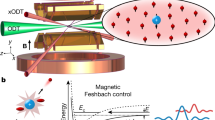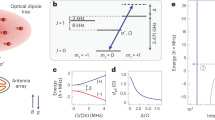Abstract
Potentials for atoms can be created by external fields acting on properties such as magnetic moment, charge, polarizability, or by oscillating fields that couple internal states. The most prominent realization of the latter is the optical dipole potential formed by coupling ground and electronically excited states of an atom with light. Here, we present an extensive experimental analysis of potentials derived from radiofrequency (RF) coupling of electronic ground states. The coupling is magnetic and the vector character allows the design of versatile microscopic state-dependent potential landscapes. Compared with standard magnetic trapping, we find no additional heating or (collisional) loss up to densities of 1015 atoms cm−3. We demonstrate robust evaporative cooling in RF potentials, which allows easy production of Bose–Einstein condensates in complex potentials. Altogether, this makes RF dressing a new powerful tool for manipulating ultracold atoms complementary to magnetic trapping and optical dipole potentials.
This is a preview of subscription content, access via your institution
Access options
Subscribe to this journal
Receive 12 print issues and online access
$209.00 per year
only $17.42 per issue
Buy this article
- Purchase on Springer Link
- Instant access to full article PDF
Prices may be subject to local taxes which are calculated during checkout





Similar content being viewed by others
References
Cohen-Tannoudji, C., Dupont-Roc, J. & Grynberg, G. Atom-Photon Interactions (Wiley, New York, 1992).
Grimm, R., Weidemüller, M. & Ovchinnikov, Y. B. Optical dipole traps for neutral atoms. Adv. At. Mol. Opt. Phys. 42, 95–170 (2000).
Muskat, E., Dubbers, D. & Schärpf, O. Dressed neutrons. Phys. Rev. Lett. 58, 2047–2050 (1987).
Agosta, C. C., Silvera, I. F., Stoof, H. T. C & Verhaar, B. J. Trapping of neutral atoms with resonant microwave radiation. Phys. Rev. Lett. 62, 2361–2364 (1989).
Spreeuw, R. J. C et al. Demonstration of neutral atom trapping with microwaves. Phys. Rev. Lett. 72, 3162–3165 (1994).
Zobay, O. & Garraway, B. M. Two-dimensional atom trapping in field-induced adiabatic potentials. Phys. Rev. Lett. 86, 1195–1198 (2001).
Colombe, Y. et al. Ultracold atoms confined in rf-induced two-dimensional trapping potentials. Europhys. Lett. 67, 593–599 (2004).
Schumm, T. et al. Matter-wave interferometry in a double well on an atom chip. Nature Phys. 1, 57–62 (2005).
Lesanovsky, I. et al. Adiabatic radio frequency potentials for the coherent manipulation of matter waves. Phys. Rev. A 73, 033619 (2006).
Folman, R., Krüger, P., Schmiedmayer, J., Denschlag, J. & Henkel, C. Microscopic atom optics: from wires to an atom chip. Adv. At. Mol. Opt. Phys. 48, 263–356 (2002).
Petrov, D. S., Shlyapnikov, G. V. & Walraven, J. T. M. Regimes of quantum degeneracy in trapped 1d gases. Phys. Rev. Lett. 85, 3745–3749 (2000).
Menotti, C. & Stringari, S. Collective oscillations of a one-dimensional trapped Bose-Einstein gas. Phys. Rev. A 66, 043610 (2002).
Dettmer, S. et al. Observation of phase fluctuations in elongated Bose-Einstein condensates. Phys. Rev. Lett. 87, 160406 (2001).
Krüger, P. et al. Trapping and manipulating neutral atoms with electrostatic fields. Phys. Rev. Lett. 91, 233201 (2003).
Calarco, T. et al. Quantum gates with neutral atoms: Controlling collisional interactions in time-dependent traps. Phys. Rev. A 61, 022304 (2000).
Cassettari, D., Hessmo, B., Folman, R., Maier, T. & Schmiedmayer, J. Beam splitter for guided atoms. Phys. Rev. Lett. 85, 5483–5487 (2000).
Hinds, E. A., Vale, C. J. & Boshier, M. G. Two-wire waveguide and interferometer for cold atoms. Phys. Rev. Lett. 86, 1462–1465 (2001).
Hänsel, W., Reichel, J., Hommelhoff, P. & Hänsch, T. W. Trapped-atom interferometer in a magnetic microtrap. Phys. Rev. A 64, 063607 (2001).
Stickney, J. & Zozulya, A. Influence of nonadiabaticity and nonlinearity on the operation of cold-atom beam splitters. Phys. Rev. A 68, 013611 (2003).
Shin, Y. et al. Interference of Bose-Einstein condensates split with an atom chip. Phys. Rev. A 72, 021604 (2005).
Esteve, J. et al. Realizing a stable magnetic double-well potential on an atom chip. Eur. Phys. J. D 35, 141–146 (2005).
Davis, J. D. 2d magnetic traps for ultra-cold atoms: a simple theory using complex numbers. Eur. Phys. J. D 18, 27–36 (2002).
Lesanovsky, I., Hofferberth, S., Schmiedmayer, J. & Schmelcher, P. Manipulation of ultracold atoms in dressed adiabatic rf-potentials. Preprint at <http://arxiv.org/abs/physics/0606165> (2006).
Moerdijk, A. J. & Verhaar, B. J. Collisional two- and three-body decay rates of dilute quantum gases at ultralow temperatures. Phys. Rev. A 53, R19–R22 (1996).
Julienne, P. S., Mies, F. H., Tiesinga, E. & Williams, C. J. Collisional stability of double Bose condensates. Phys. Rev. Lett. 78, 1880–1883 (1997).
Moerdijk, A. J., Verhaar, B. J. & Nagtegaal, T. M. Collisions of dressed ground-state atoms. Phys. Rev. A 53, 4343–4351 (1996).
Suominen, K.-A., Tiesinga, E. & Julienne, P. S. Nonadiabatic dynamics in evaporative cooling of trapped atoms by a radio-frequency field. Phys. Rev. A 58, 3983–3992 (1998).
White, M., Gao, H., Pasienski, M. & DeMarco, B. Bose-Einstein condensates in rf-dressed adiabatic potentials. Preprint at <http://arxiv.org/abs/cond-mat/0605393> (2006).
Castin, Y. & Dalibard, J. Relative phase of two Bose-Einstein condensates. Phys. Rev. A 55, 4330–4337 (1997).
Andrews, M. R. et al. Observation of interference between two Bose condensates. Science 275, 637–641 (1997).
Villain, P. et al. Quantum dynamics of the phase of a Bose-Einstein condensate. J. Mod. Opt. 44, 1775–1800 (1997).
Courteille, P. W. et al. Highly versatile atomic micro traps generated by multifrequency magnetic field modulation. J. Phys. B 39, 1055–1064 (2006).
Wildermuth, S. et al. Optimized magneto-optical trap for experiments with ultracold atoms near surfaces. Phys. Rev. A 69, 030901(R) (2004).
Wildermuth, S. et al. Microscopic magnetic-field imaging. Nature 435, 440 (2005).
Krüger, P. et al. Disorder potentials near lithographically fabricated atom chips. Preprint at <http://arxiv.org/abs/cond-mat/0504686> (2005).
Acknowledgements
We would like to thank Thorsten Schumm for stimulating discussions and we are grateful to Peter Krüger for critical reading of the manuscript. The atom chip used in this experiment was fabricated at the Weizman Institut of Science by S. Groth. We acknowledge financial support from the European Union, through the contracts IST-2001-38863 (ACQP), MRTN-CT-2003-505032 (Atom Chips), Integrated Project FET/QIPC ‘SCALA’, and the Deutsche Forschungsgemeinschaft, contract number SCHM 1599/1-1. I.L. acknowledges support from the European Community and its 6th Community Frame (program of Scholarships of Distinction ‘Marie Curie’).
Author information
Authors and Affiliations
Corresponding authors
Ethics declarations
Competing interests
The authors declare no competing financial interests.
Rights and permissions
About this article
Cite this article
Hofferberth, S., Lesanovsky, I., Fischer, B. et al. Radiofrequency-dressed-state potentials for neutral atoms. Nature Phys 2, 710–716 (2006). https://doi.org/10.1038/nphys420
Received:
Accepted:
Published:
Issue Date:
DOI: https://doi.org/10.1038/nphys420
This article is cited by
-
On the observability of Pauli crystals in experiments with ultracold trapped Fermi gases
Scientific Reports (2017)
-
Matter-wave beam splitter on an atom chip for a portable atom interferometer
Applied Physics B (2017)
-
Integrated Mach–Zehnder interferometer for Bose–Einstein condensates
Nature Communications (2013)
-
Matter waves in a new light
Nature Physics (2013)
-
Thick-film technology for ultra high vacuum interfaces of micro-structured traps
Applied Physics B (2012)



